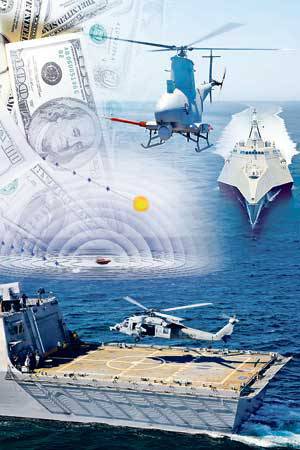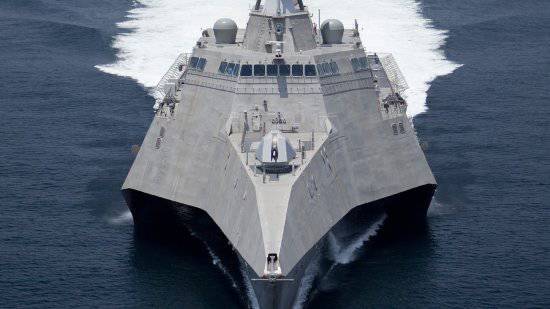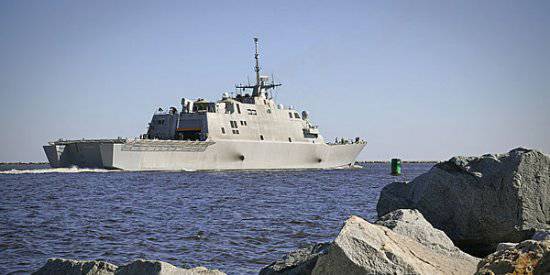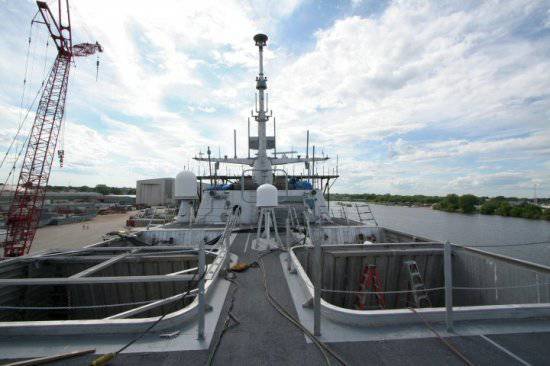Stranded
 In recent months, one of the main programs of the US Navy - the design and construction of fifty multi-purpose littoral warships (LBK) - is experiencing one blow after another. After analyzing the course of its implementation, the State Budget and Control Department (GAO) in August presented a report to Congress, in which it exposed the actions of the US Navy command and the involved contractor companies to rather sharp criticism. In September, the costs of the program were significantly curtailed - so to speak, “until clarification”, and then the news came that the gas turbine unit of one of the prototypes failed. True, the admirals were quick to say that replacing the turbine "would not seriously affect the approved test schedule."
In recent months, one of the main programs of the US Navy - the design and construction of fifty multi-purpose littoral warships (LBK) - is experiencing one blow after another. After analyzing the course of its implementation, the State Budget and Control Department (GAO) in August presented a report to Congress, in which it exposed the actions of the US Navy command and the involved contractor companies to rather sharp criticism. In September, the costs of the program were significantly curtailed - so to speak, “until clarification”, and then the news came that the gas turbine unit of one of the prototypes failed. True, the admirals were quick to say that replacing the turbine "would not seriously affect the approved test schedule."Highly recommend ...
The GAO report was named “The ability of the Navy to cope with problems encountered in littoral warships, will directly affect their capabilities” and was prepared based on a request from lawmakers concerned about the implementation of the program, which is planned to spend more than 2035 billion dollars before the financial year 25 . Moreover, in case of failure, the Pentagon not only risks losing huge allocations, but also ends up with a naked “sea flank” - after all, the American fleet will then be left without LBK, designed to ensure safety in coastal waters (of the enemy) and on sea lines of communications, and combat submarines , convoy and mine action.
Andrei Sedykh collage
The main conclusion of the document prepared for the congress: the naval commanders need to “re-create and more realistic” the calculation of financial indicators for littoral ships, objectively assess the timeframe for eliminating the identified deficiencies and making necessary changes to the project, and more effectively control the development and procurement of serial combat modules ( sets of special weapons and equipment). The leadership of the naval forces agreed with all the "ideas", but the problems did not disappear anywhere.
So, making changes to the second Freedom and Independence types already on the stocks will definitely require additional costs - man-hours and money. This, in particular, may adversely affect the profit level of the main contractors for the program. Although representatives of Lockheed Martin have so far declared that their second LBK, Fort Worth, is already ready for 60%, and the corporation has not gone beyond the time schedule and the approved price parameters. A similar position regarding its LBK Coronado is also held in the concern General Dynamics.
GAO was particularly concerned about the delays in the supply by various subcontractors of specialized interchangeable combat modules, which include targeted weapons and equipment (for more details, just below). According to the experts involved in writing the report, if there is no order in this matter, we should not expect accurate implementation of the plan and compliance with the LBK program budget. In addition, the performance of the special modules and the ships themselves must also be proved in practice.
“Until the LBK’s combat capabilities are convincingly demonstrated during the relevant tests,” the final part of the document says, “the Navy command cannot say that the ships themselves and the special combat modules that the fleet acquires can effectively solve the tasks that the US Navy intends lay on them. "
The main "sores"
Expanding each of the LBK types literally “on the shelves,” experts of the State Budget Control Department found out that a number of very important structural elements, as well as weapon systems and equipment of the lead ships, were Freedom (Lockheed Martin) and Independence (“ General Dynamics and Ostal USA ”) - has not yet passed the full test cycle or has not yet been established. Although since the beginning of the implementation of one of the most ambitious programs of the US Navy has passed ten years. Meanwhile, the sailors are analyzing the results of the combat service of the LBK Freedom (for Independence it is ahead).
The main potential threat to the Freedom-type LBK, until this is refuted by test results, GAO experts considered the readiness of ship systems and the ability of the crew to use for their intended purpose such complex "applications" as uninhabited surface and underwater remote-controlled vehicles plus Drones. True, the equipment designed to move them around the ship, especially in the volume of compartments specially allocated for storage, is still under development and will appear on board the LBK only ... in 2013.
That is, LBK is already undergoing tests, but all the devices mentioned above are not yet, and the equipment for their proper operation will appear only after three years!
The experts were alarmed and the location of the slip was too low, with the help of which remote-controlled boats are launched and taken on board, because under strong agitation it will be flooded with water, and this will complicate the team’s actions. The very same water can penetrate into the internal compartments of the ship. However, some of the experts' concerns were dispelled during the recently completed combat service of the LBK Freedom: the sailors repeatedly launched and took on board an 11-meter inflatable motorboat on the move, the nature of operation of which is largely similar to the use of an unmanned surface apparatus.
Similar problems associated with the possible unavailability of equipment for a similar purpose were identified by experts at the Independence-type LBC. We are talking about a special crane for launching and lifting aboard surface and underwater uninhabited vehicles, which has not yet passed the entire test cycle. However, it is not yet possible to fully study all the shortcomings of this LBK - like Freedom, it was handed over to the US Navy in unfinished form, with separate ship systems not installed and unresolved comments. Improvements to be done by ship repair enterprises fleetafter which the ship will go on a comprehensive test.
In addition, the 2 of August of this year experienced an “exciting nuisance” with one of the UAVs included in the target load of the literal ships. During the next flight tests of the MQ-8B “Fire Scout” UAV, conducted near Washington, the ground crew on the 23 minute (!) Lost control of the vehicle. The reason is either unknown or carefully hidden. But the result is known - all the "Fire Scouts" were temporarily "put on the joke." American specialized media reported this not so long ago, suggesting that the “trouble” happened because of software flaws.
"Capricious" modules
Special attention was paid to specialized replaceable combat modules, the possibility of which the Pentagon views at LBK as one of the most important advantages of these ships (for 55 planned to purchase LBK, it is planned to purchase 64 combat modules, including anti-mine - 24, for conducting surface warfare - 24, anti-submarines - 16).
Now at various stages of development are three of the most important combat module: to defeat surface ships, to combat submarines, for conducting mine action. This year, a special module was created specifically for combat service of LBK “Freedom”, designed to solve problems in the field of maritime security (provides for the deployment on board of two inspection crews of 19 military personnel with appropriate weapons and equipment). The possibilities and feasibility of creating other specialized combat modules are being studied. And according to the GAO report, none of the projects already approved for development or promising combat modules do not go according to schedule, and in some cases the situation does look catastrophic at all, capable of having the most negative impact on the implementation of the entire LBK program.
In the most difficult situation, as the experts found out, there is a combat module for mine operations (mine defense, PMO). The structure of a typical combat module PMO, designed to detect, classify, localize and destroy any sea mines in any part of the World Ocean, should include aviation laser detection system and mine destruction system, GAS AN / AQS-20A, remotely controlled anti-mine system ("robot - mine hunter"), coast reconnaissance system (with the possibility of comprehensive analysis of the obtained data), a single non-contact mine-sweeping system (aircraft and ship basing), 30-mm cannon mount for the destruction of sea mines, as well as an uninhabited boat minesweeper, equipped with a special non-contact mine-sweeping system consisting of a magnetic trawl and an acoustic signal generator.
However, today, of the eight basic elements of the PMO module, none has reached the combat readiness stage. According to the most optimistic calculations, three components will be ready not earlier than next year, two more - in 2012-m, two - in 2015-m. And RAMICS (Rapid Airborne Mine Clearance System) - a fast-fire 30-mm gun mount with ammunition in the form of “supercavitating shells” to shoot naval mines - can be put into service already in 2017 year! Then LBK and gain full combat readiness.
In addition, as it turned out during the tests, one of the key elements of the PMO combat module is the ALMDS aviation laser mine detection system installed onboard the helicopter is capable of detecting the presence of such objects with the required accuracy only at shallow depths - almost at the bottom of the ship itself, and not up to 9 – 10 meters from the sea surface, as required. The US Navy had to suspend the procurement of both the ALMDS and the remote-controlled anti-mine system from 2005, which also failed to justify its hopes.
There are many problems with other components of the mine module, which forced the developers and the customer to postpone its first tests to the 2013 year (they will involve the Independence Division). Additional complications here are associated with too slow certification of helicopters MH-60S and UAV MQ-8B, which should be based on the LBK. The first one has passed the same certification this year and will reach a state of full combat readiness in 2011, and the “trouble” with the Fire Scout has already been mentioned earlier.
In general, today, only the aviation system for classifying and destroying bottom and anchor mines in shallow waters and the coastal intelligence system, which was tested by MH-53 helicopters, was able to detect and correctly identify all the mines on the shore, proved their performance. In the future, this system will be installed on the UAV MQ-8B).
For the time being, the customer is disappointed with the combat module for conducting a surface war - finding, classifying, escorting and destroying small surface targets, escorting convoys and individual ships, as well as providing security in designated areas.
This module is very important for the effective operation of the future LBK fleet, designed to operate primarily in the enemy’s littoral zone or off the coast of the allied countries, but so far its ability to solve the tasks assigned to it has not been confirmed in practice. By the way, this was not reported by the authors of the report to Congress, but by representatives of the command of the US Navy. In addition, one of the key elements of the combat module is the NLOC-LS (Non-Line-of-Sight-Launch-System) rocket system with a container launcher on 15 guided missiles designed to hit stationary and mobile targets at a distance of up to 21 miles ( 38,9 km), failed in July 2009 year of testing and rejected by the customer from the delivery.
It is noteworthy that this system was borrowed by the fleet from the arsenal of the FCS program implemented by the US Army (Perspective Combat System or, as they often often say, Future Combat System), where it also failed miserably during the six rocket firing in January February 2010, only two hits were achieved.
Problems also arose with the adoption of the MH-60R ship-based helicopter, capable of carrying lowered GUS, radio-acoustic buoys, EW complex, torpedoes and Hellfire air-to-surface missile system. Despite the fact that the state of the initial operational readiness of the machine reached 2005 in the year and in January 2010 fleet received 46 from 252 planned for the purchase of helicopters, the first exit of MH-60R to combat service on board LBK is scheduled only for 2013 year - last year's tests deficiencies in the operation of the data exchange line and individual elements of the sighting system
For the price will not stand?
The positive dynamics in the Congress were also caused by the dynamics of growth in the purchase price of LBK. So, for example, if initially for the construction of Freedom (LCS 1) it was supposed to spend 215,5 million dollars (excluding R & D costs), then its final price jumped to 537 million dollars. Excess - by 321,5 million, or by 149,2%. For the head LBK of another type - “Independence” (LCS 2) - the percentage overrun is somewhat more modest, “only” by 136,6%, but in absolute terms even more - by 350,5 million dollars. For the second pair of LBK, official growth is 97 million dollars (7,7%), but when recalculated from the initial cost of the budget of the 2006 financial year, the excess is 917,7 million dollars (208,5%). In addition, both the Freedom and the Independence fleet received in "unfinished form and with significant technical deficiencies." At the same time, according to experts, if the American admirals would continue to wait for contractors to "complete and eliminate the deficiencies", the ships would have risen in price even more - the completion of work on naval-owned shipyards would have cost the budget much less than at the factories of private corporations.
And everything would be fine if only the program cost overruns were fixed - the time periods for its implementation were also increased: for the head ships of the Freedom and Independence types they were already 20 and 26 months, respectively.
"The ability of the naval command to ensure that the combat missions are ready for the assigned tasks and affordable LBK remains unproved," the GAO report said.
It should be noted that the full version of the document is classified, and in its open part there is no information about what shortcomings were identified by experts with regard to anti-submarine weapons and the main power plant littoral warships. However, it became known that the specialists of the Navy consider the PLO complexes to "slightly increase the combat potential of the ship and hardly contribute to the effective solution of their tasks." As for the GEM, a lot of things - at least with the Freedom ships - became clear two months ago ...
Blades failed
... The accident occurred near the coast of California 12 September during the next exit of the Freedom into the sea for testing various tasks. According to eyewitnesses, a sudden "strong vibration" appeared in the gas-turbine installation of the starboard, after which the commander decided to stop both GTUs and return to the base on diesel engines. An inspection showed that the cause of the accident was the destruction of turbine blades, which damaged the installation. And this is on the eve of the date of the final selection of the LBK type for serial construction and the issuance of a contract for the first series of ten ships.
The main power plant of LBK Freedom is a diesel-gas turbine, it includes two MT30 gas-turbine units produced by Rolls-Royce, two Colt-Pilstic diesel units and four Isotta Fraschini V1708 diesel generators each 800 kW. Rated power of one GTU - 48280 l. with. (36 MW - at a temperature of 38 degrees, or 40 MW - at a temperature of 15 degrees). The Fridom does not have propellers and, accordingly, bulky propeller shafting and shafts — four water cannons of the Kameva company (a subsidiary of Rolls-Royce) are used as propellers, two of which are fixed and two others are rotating.
It is noteworthy that the gas-turbine installations of the British firm got into the warships of the US Navy for the first time, and that's such an embarrassment at the first LBK in the series! Exclusively - to the delight of "General Electric", whose GTU since the 70-s have been operated on the ships of the American fleet, including LBK of the second type ("Independence"). About the likely negative consequences of using the GTU MT30 were warned by some experts at the initial stage of implementing the LBK program, taking as an argument the fact that the MT30 is a new shipboard GTU that does not have the “authority” of the sailors.
On the one hand, this is true, but on the other hand, the gas turbine engine in the GTU belongs to the well-known Trent family. The operating time of these aviation gas turbine engines (GTX MT30 was created on the basis of Trent 800, which is equipped including the Boeing 777 airliner and has 80% compatibility with the aircraft engine), according to the management of Rolls-Royce, exceeded 30 million flight hours. The main contractor for the single-frame LBK of the Freedom type - Lockheed Martin Corporation preferred the British GTU to the American one because of its greater power - 48 280 l. with. vs xnumx xnumx l. with. for GTU LM36, since initially the customer was tasked to ensure the maximum speed of the ship is not less than 500 nodes (in tests, however, the developers did not manage to confirm this in practice). However, the MT2500 is heavier and more cumbersome than the LM50. Now it turned out that it was not completely modified.
But there is a place for positive emotions in the accident at Freedom - it allowed to work out the process of repairing the gas turbine unit associated with the extraction of large parts of the installation, including the gas turbine itself. In this case, the procedure for replacing the GTU can be carried out by the team and a small group of coastal service specialists, without being docked. That is, outside the place of permanent deployment of the ship.




Information